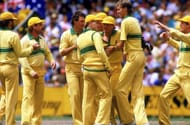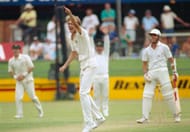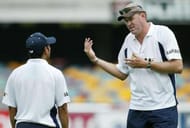A fast bowler whose career began with a four-wicket haul in his first Test match and ended with a five-wicket haul in his last match should ideally find a name for himself amongst the greats of the game.
But rarely are things ideal in the world; the name Bruce Anthony Reid does not ring a bell with many cricket followers.
Fast bowling requires more than just the art to bowl fast and swing the ball. As the great English bowler, Fred Trueman, said, “To be a great fast bowler, you need a big heart and a big bottom”.
A short but impressive career
Bruce Reid probably had everything that was needed to be a successful fast bowler but his body did not support him. At 6’8’’ (203 cm), he was a tall cricketer who had the knack of straightening the ball into the right-hander as well as slanting it away. And along with this, he had a natural steep bounce.
All this made him a lethal left-arm pace bowler and he immediately became Australia’s mainstay. He had made his debut against India in 1985 at Adelaide alongside Merv Hughes and Geoff Marsh.
But constant injuries ensured that he could barely play only the half the number of matches played by Hughes and Marsh. He played 27 Tests between 1985 and 1992 and took 113 wickets at an impressive average of 24.63. He also played 61 ODIs with moderate success.
The Melbourne Cricket Ground (MCG) was his favourite hunting ground. Reid took 13 wickets against England in the Ashes and took 12 wickets in the same year against India at this iconic ground.
Injuries halted a promising career
One of his test-mates had famously said, “He never played two Tests in a row”. While this was an exaggeration, the fact remains that Reid’s body was unable to cope with the strains of fast bowling.
The popular view was that he was too fragile for his craft. After one of his many injuries, two discs from his back were removed and a metal plate was inserted.
One of the reasons given for his career full of injuries is that he was used as a stock bowler much before his frame was ready for this arduous task. He is at number three in the list of most balls delivered by Australian fast bowlers under the age of 23 since 1970 (behind Craig McDermott and Dennis Lillee).
Player | Number of deliveries bowled | Number of Overs bowled |
Craig McDermot | 3035 | 505.5 |
Dennis Lillee | 1471 | 245.2 |
Bruce Reid | 1407 | 234.3 |
Mitchell Starc | 1379 | 229.5 |
Jason Gillespie | 1370 | 228.2 |
This is supported by data collected on the formative years of fast bowling by Cricket Australia. As per that data, bowlers are likely to face a range of injury problems until their bodies mature fully.
“We were in that era where it was semi-professional”
Reid’s is a classical case study on how teams must distribute the workload between fast bowlers to increase their longevity. Interestingly, the Indian cricket team, whom Reid coached, did try to manage it in the case of Javagal Srinath.
Unfortunately for Reid, he played in an era when there wasn’t much science involved in training methods. Hence, despite the immense talent that he possessed, he played his last international match at a young age of 29 years.
He had once said, "We were in that era where it was semi-professional. We weren't earning the big bucks they're earning now. Some of us were still working, then trying to go to cricket and play and try to fit in as much as you could. “
“My biggest ‘if only’ is Bruce Reid”
Post his retirement, Reid became a bowling coach and worked with international teams like India and Zimbabwe.
With his coaching, he can contribute to try and change the future of budding fast bowlers. What he cannot change is the past or his playing career.
Reid’s long-time national coach, Bob Simpson, had spoken in regret of the Australian fast bowler’s career and said, “My biggest 'if only' is Bruce Reid. If he had stayed fit, there is no doubt at all that Australia would have been recognised as world champions two or three years before we were able to claim that position, simply because he was a great bowler, one of the finest bowlers I have ever seen."
But much like in other spheres of life, there is no space for the words “if only” in cricket.
Follow IPL Auction 2025 Live Updates, News & Biddings at Sportskeeda. Get the fastest updates on Mega-Auction and cricket news




